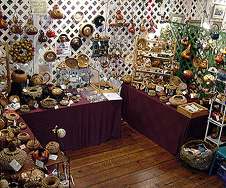 by Lynn Hoyt
by Lynn Hoyt
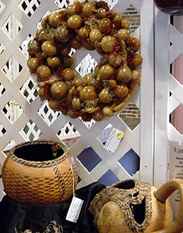
Each time we set up, it differs, according to how much space we have, and what is around us. Generally, our booth is like a small shop. Tables
and shelves are configured in a U shape, which invites people to come inside, out of the flow of traffic for a closer look. This gives the most
efficient use of space, as opposed to a table set up like a barrier
between artist and customers. It also allows us to pack an amazing amount of merchandise into a small space. It is not uncommon for other booth occupants to ask if our booth is larger than theirs!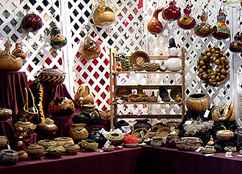
A lattice screen separates our booth
from the next, and gives us extra eye-level space for hanging work. We
use solid dark colored non-wrinkle table covers that reach to the floor. (We have purchased yards and yards in various dark colors, for very little at discount stores.)
This gives a non-clashing dramatic effect that plays up the work.

One of our most effective techniques is to display work at different
levels, with lots of pieces around eye level. We use wooden folding
shelves, placing them on top of the tables for maximum height. Buckets, stools, cans, and boxes are arranged in
clusters under table drapes to raise some pieces so that the viewer's
eye can travel up and down, rather than a straight line. 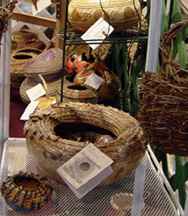 These
vertical elements create focal points which make the display an
adventurous journey of discovery, rather than boring flat sameness. Using heights keeps small hands from touching some of the more
delicate pieces. Small individual display stands and racks
are also used to vary the height of some pieces on the tables. They are
great for angling baskets and gourds, both to vary the lines on the table, and to show each piece off to it's best effect.
These
vertical elements create focal points which make the display an
adventurous journey of discovery, rather than boring flat sameness. Using heights keeps small hands from touching some of the more
delicate pieces. Small individual display stands and racks
are also used to vary the height of some pieces on the tables. They are
great for angling baskets and gourds, both to vary the lines on the table, and to show each piece off to it's best effect.
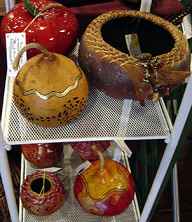
Folding metal floor shelves are placed at the ends of tables for more vertical elements. Small covered tables and stools are used on the floor in little spaces between large tables, in corners, or to extend the booth outwards. Stacking plastic bins used for storage and transport do double duty as tall display pedastals when covered with cloths. This leaves a lot of room free under the tables for storing other utilities.
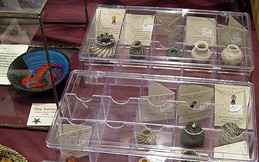
For jewelry and miniature items, we wire racks, shadow and curio boxes to lattice or shelf units. Other miniatures are shown in glass or plastic display cases on the table. This keeps small pieces from falling to the floor or walking off by themselves. Some ornaments are displayed in baskets and others are hung from ornament trees and brackets in different locations - high and low - throughout the booth. If a customer doesn't see them in one place, they might see them in another.
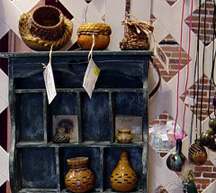 We also try to move items around during a show, when there are lulls in shopping. Sometimes a particular "spot" is hot to draw the eye, and we try to fill "holes" made by sales.
We also try to move items around during a show, when there are lulls in shopping. Sometimes a particular "spot" is hot to draw the eye, and we try to fill "holes" made by sales.

We generally use our own (for sale) pieces as containers for display. We try to rotate them during the show, so people realize that the container is also for sale. It just does not seem good policy to have "not for sale" or imported baskets on display. Sometimes we will use an unfinished gourd as a container, as well. We use business card holders which which we have made, from the same materials as our wares.

We've found that intermingling our work throughout the display is more
pleasing to the eye than keeping it separated. Though we each have our
own style, this works because our work compliments each others' and our
use of materials overlaps. 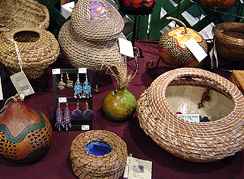 Because we both like to experiment, there is
always a variety of work, from colorful and funky to natural. We
try to arrange groupings in an artful way, varying sizes and shapes,
creating focal points, adding height, and tilting some pieces. Because
we are there to sell, we put as much of our work out as we can. More
choices mean more sales, and makes for an interesting shop that people
want to spend time in.
Because we both like to experiment, there is
always a variety of work, from colorful and funky to natural. We
try to arrange groupings in an artful way, varying sizes and shapes,
creating focal points, adding height, and tilting some pieces. Because
we are there to sell, we put as much of our work out as we can. More
choices mean more sales, and makes for an interesting shop that people
want to spend time in.

Extra lighting brightens up dark areas or adds a dramatic
touch for showcasing particular pieces. It makes a difference even at
outdoor shows. We clamp spotlights and worklights to lattices or
shelves. Goose neck desk lamps are placed in the background to shine
over a piece and help create a small focal point. During holiday
shows, we use a few strings of Christmas lights in the background
just to add extra sparkle.

We try to use ALL the space we are given...from floor to as high as we can reach. Garden and outdoor pieces are really great for the floor, and for hanging too. Birdhouse gourds gets lots of scrutiny when hung at many levels. Coat hangers are cheap and can be readily bent in to fabulous multi-purpose hooks of many lengths, which easily bend around basket handles. It only takes a couple of shows for them to acquire a great rusty patina which lets them blend in beautifully. At outdoor shows, hanging pieces are suspended from a long chain, which dips across the eve or side of the tent. 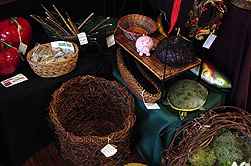
We make sure pieces displayed very low are sturdy enough to withstand the traffic - including little hands.
Finally, we have come to understand that signage can be a very helpful
public relations and marketing tool. Our shop sign lets folks know that
we are local and our materials are collected and grown locally. To make
sure people can make a connection between us, our work and themselves,
we hang short artist statements, and post information about our
materials, techniques and awards. We also have a book with all this and
photos of our shows, award-winning pieces, etc. Individual works are
tagged as award winners as well.
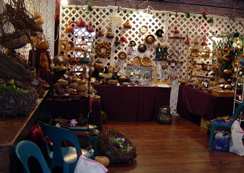
When we think we have finished our setup, we always get out the digital cameras and snap a bunch of photos. Taking pictures of the booth overall, as well as the individual displays helps us remember what to do each time. It documents the show for us, but also gives us another perspective. More than once, we have noticed glaring problems with the display after seeing it in photos...like the white garbage bags in the photo at right. Funny how it is so difficult to see these things sometimes.
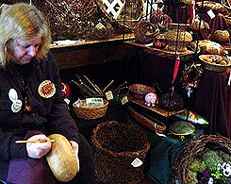
To generate more interest, we both demonstrate a technique. Usually, Pamela coils and I carve a gourd. Sometimes we run a People Basket", which is raffled off at the end of the show.
With each show we fine-tune our booth a bit more. This is not a quick set-up. It seems to take us longer than all the other exhibitors; usually about 3 hours setup, and 2 hours breakdown...longer with a tent. But our practice has paid off,
as we are getting faster, and our display better, every time!